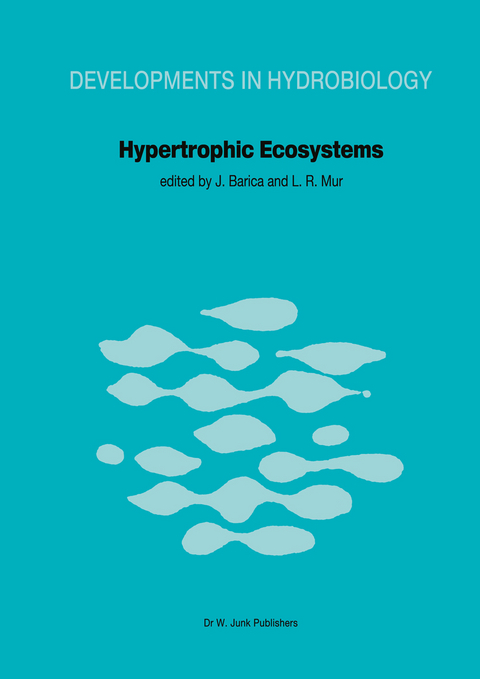
Hypertrophic Ecosystems
Kluwer Academic Publishers (Verlag)
978-90-6193-752-4 (ISBN)
- Titel z.Zt. nicht lieferbar
- Versandkostenfrei
- Auch auf Rechnung
- Artikel merken
Session 1: Definition, characterization and causes of hypertrophy.- The summer limnology of Lake Waahi, New Zealand.- Identification of different phosphorous forms and their role in the eutrophication process of Lake Balaton.- Metalimnetic gradient and phosphorus loss from the epilimnion in stratified eutrophic lakes.- The influence of sediments on changed phosphorus loading to hypertrophic L. Glumsø.- The cyanobacterium Microcystis aeruginosa kg. and the nitrogen cycle of the hypertrophic Lake Brielle (The Netherlands).- Comparison of hypertrophy on a seasonal scale in Dutch inland waters.- Control of undesirable algae and induction of algal successions in hypertrophic lake ecosystems.- Occurrence of Oscillatoria agardhii and some related species, a survey.- The influence of periodicity in light conditions, as determined by the trophic state of the water, on the growth of the green algae Scenedesmus protruberans and the cyanobacterium Oscillatoria agardhii.- The role of microlayers in controlling phytoplankton productivity.- Short-term load-response relationships in shallow, polluted lakes.- The importance of trophic-level interactions to the abundance and species composition of algae in lakes.- Vegetation changes in the nutrient-rich shallow Lake Hjälstaviken.- N2-fixing cyanobacteria; why they do not become dominant in Dutch, hypertrophic lakes.- Session 2: Stability of hypertrophic ecosystems and causes of hypertrophy.- Nirate overdose: effects and consequences.- A chemical model to describe nutrient dynamics in lakes.- Changes in the respiration and anaerobic nutrient regeneration during the transition phase of reservoir development.- Modelling carbon and phosphorus in a small hypertrophic North German lake.- An algal bloom model as a tool to simulate managementmeasures.- Phosphorus stability in a hypereutrophic lake.- Structural and functional quantification in a series of Hungarian hypertrophic shallow lakes.- Muddy odour in fish from hypertrophic waters.- The importance of hydrologic factors on the relative eutrophic impacts of point and non-point pollution in a reservoir.- Environmental constraints on Anabaena N2- and CO2-fixation: effects of hyperoxia and phosphate depletion on blooms and chemostat cultures.- Toxicity fluctuations and factors determining them.- Stability and multiple steady states of hypereutrophic ecosystems.- Session 3: Foodchain properties, productivity and utilization of hypertrophic ecosystems.- On the role of soil in the maintenance of fish ponds’ fertility.- Fish as a factor controlling water quality in ponds.- The role of fishery management in counteracting eutrophication.- Fish production in some hypertrophic ecosystems in South India.- Session 4: Rehabilitation.- Enrichment and recovery of a Malaysian reservoir.- Lake treatment with hydrogen peroxide.- Characterization of the recovery processes in hypertrophic lakes in terms of actual (lake water) and potential (algal assay) chloropically.- Morphometrically conditioned eutrophy and its amelioration in some British Columbia lakes.- Hartbeespoort Dam - a case study of a hypertrophic, warm, monomictic impoundment.- Cascade reservoirs as a method for improving the trophic state downstream.- Concluding Remarks.- Summaries and Abstracts.- The effect of pig manure and mineral fertilization on a eutrophic lake ecosystem.- Hypertrophy in slow flowing rivers.- CO2-uptake as a measure of bacterial production.- Response of shallow hypertrophic lakes to reduced nutrient loading.- Fish as a regulator of structure and function in eutrophic lake ecosystems.-Algenbekämpfung durch Zusatz von Kalk und Dolomithydrat.- Possible triggering mechanisms for the collapse of Aphanizomenon-flos-aquae blooms.- Self-purification and respiration in polysaprobic area of natural flowing waters receiving raw domestic sewage.- Short-circuit metabolism in highly eutrophic lakes - relationship between primary production and decomposition rates.- Heterotrophic functions in the freshwater carbon cycle.- Effects of temperature and temperature-nutrient interactions on phytoplankton growth.- Natural and induced sediment rehabilitation in hypertrophic lakes.- Aspects of biological competition between Stigeoclonium tenue and Cladophora glomerata, two filamentous green algae, characteristic of eutrophic waters.- Seasonal succession and standing crop determinations of the epiphytic algae in two hypertrophic lakes.- Nitrogen transformations in artificial loaded limnocorrals.- Zur quantitativen Bestimmung der potentielle Bioproduktion in aquatischen Ökosystemen mittels Algentest.
| Erscheint lt. Verlag | 30.11.1980 |
|---|---|
| Reihe/Serie | Developments in Hydrobiology ; 2 |
| Zusatzinfo | XVIII, 348 p. |
| Verlagsort | Dordrecht |
| Sprache | englisch |
| Maße | 210 x 297 mm |
| Themenwelt | Naturwissenschaften ► Biologie ► Limnologie / Meeresbiologie |
| Naturwissenschaften ► Biologie ► Ökologie / Naturschutz | |
| ISBN-10 | 90-6193-752-3 / 9061937523 |
| ISBN-13 | 978-90-6193-752-4 / 9789061937524 |
| Zustand | Neuware |
| Haben Sie eine Frage zum Produkt? |
aus dem Bereich


